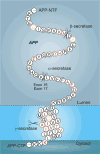Correlating familial Alzheimer's disease gene mutations with clinical phenotype
- PMID: 20387306
- PMCID: PMC3937872
- DOI: 10.2217/bmm.09.92
Correlating familial Alzheimer's disease gene mutations with clinical phenotype
Abstract
Alzheimer's disease (AD) causes devastating cognitive impairment and an intense research effort is currently devoted to developing improved treatments for it. A minority of cases occur at a particularly young age and are caused by autosomal dominantly inherited genetic mutations. Although rare, familial AD provides unique opportunities to gain insights into the cascade of pathological events and how they relate to clinical manifestations. The phenotype of familial AD is highly variable and, although it shares many clinical features with sporadic AD, it also possesses important differences. Exploring the genetic and pathological basis of this phenotypic heterogeneity can illuminate aspects of the underlying disease mechanism, and is likely to inform our understanding and treatment of AD in the future.
Figures



Similar articles
-
The genetic architecture of Alzheimer's disease: beyond APP, PSENs and APOE.Neurobiol Aging. 2012 Mar;33(3):437-56. doi: 10.1016/j.neurobiolaging.2010.03.025. Epub 2010 Jul 1. Neurobiol Aging. 2012. PMID: 20594621 Free PMC article. Review.
-
APP, PSEN1, and PSEN2 Mutations in Asian Patients with Early-Onset Alzheimer Disease.Int J Mol Sci. 2019 Sep 25;20(19):4757. doi: 10.3390/ijms20194757. Int J Mol Sci. 2019. PMID: 31557888 Free PMC article.
-
Novel presenilin mutations within Moroccan patients with Early-Onset Alzheimer's Disease.Neuroscience. 2014 Jun 6;269:215-22. doi: 10.1016/j.neuroscience.2014.03.052. Epub 2014 Apr 4. Neuroscience. 2014. PMID: 24704512
-
Gene mutations in a Han Chinese Alzheimer's disease cohort.Brain Behav. 2019 Jan;9(1):e01180. doi: 10.1002/brb3.1180. Epub 2018 Dec 14. Brain Behav. 2019. PMID: 30549411 Free PMC article.
-
Gene mutations associated with early onset familial Alzheimer's disease in China: An overview and current status.Mol Genet Genomic Med. 2020 Oct;8(10):e1443. doi: 10.1002/mgg3.1443. Epub 2020 Aug 6. Mol Genet Genomic Med. 2020. PMID: 32767553 Free PMC article. Review.
Cited by
-
Forgetful and robotic: tap on a gene!Neurol Sci. 2016 Jul;37(7):1185-7. doi: 10.1007/s10072-014-2059-z. Epub 2015 Jan 8. Neurol Sci. 2016. PMID: 25567082 No abstract available.
-
A Three-Dimensional Alzheimer's Disease Cell Culture Model Using iPSC-Derived Neurons Carrying A246E Mutation in PSEN1.Front Cell Neurosci. 2020 Jun 12;14:151. doi: 10.3389/fncel.2020.00151. eCollection 2020. Front Cell Neurosci. 2020. PMID: 32655369 Free PMC article.
-
Magnetic resonance imaging evidence for presymptomatic change in thalamus and caudate in familial Alzheimer's disease.Brain. 2013 May;136(Pt 5):1399-414. doi: 10.1093/brain/awt065. Epub 2013 Mar 28. Brain. 2013. PMID: 23539189 Free PMC article.
-
The presenilin 1 P264L mutation presenting as non-fluent/agrammatic primary progressive aphasia.J Alzheimers Dis. 2013;36(2):239-43. doi: 10.3233/JAD-122092. J Alzheimers Dis. 2013. PMID: 23579325 Free PMC article.
-
APOE4-induced patterned behavioral decline and neurodegeneration requires endogenous tau in a C. elegans model of Alzheimer's disease.bioRxiv [Preprint]. 2025 May 15:2025.05.06.652574. doi: 10.1101/2025.05.06.652574. bioRxiv. 2025. PMID: 40463229 Free PMC article. Preprint.
References
Bibliography
-
- Rossor MN, Newman S, Frackowiak RS, Lantos P, Kennedy AM. Alzheimer's disease families with amyloid precursor protein mutations. Ann NY Acad Sci. 1993;695:198–202. - PubMed
-
- Goate A, Chartier-Harlin MC, Mullan M, et al. Segregation of a missense mutation in the amyloid precursor protein gene with familial Alzheimer's disease. Nature. 1991;349(6311):704–706. - PubMed
-
- Sherrington R, Rogaev EI, Liang Y, et al. Cloning of a gene bearing missense mutations in early-onset familial Alzheimer's disease. Nature. 1995;375(6534):754–760. - PubMed
-
- Levy-Lahad E, Wasco W, Poorkaj P, et al. Candidate gene for the chromosome 1 familial Alzheimer's disease locus. Science. 1995;269(5226):973–977. - PubMed
-
- Rovelet-Lecrux A, Hannequin D, Raux G, et al. APP locus duplication causes autosomal dominant early-onset Alzheimer disease with cerebral amyloid angiopathy. Nat Genet. 2006;38(1):24–26. Duplication of the amyloid precursor protein locus was found to be a cause of autosomal dominantly inherited early-onset Alzheimer's disease (AD), with prominent amyloid angiopathy. - PubMed
Website
-
- Alzheimer Disease and Frontotemporal Dementia Mutation Database. www.molgen.ua.ac.be/ADMutations.
Publication types
MeSH terms
Substances
Grants and funding
LinkOut - more resources
Full Text Sources
Other Literature Sources
Medical
